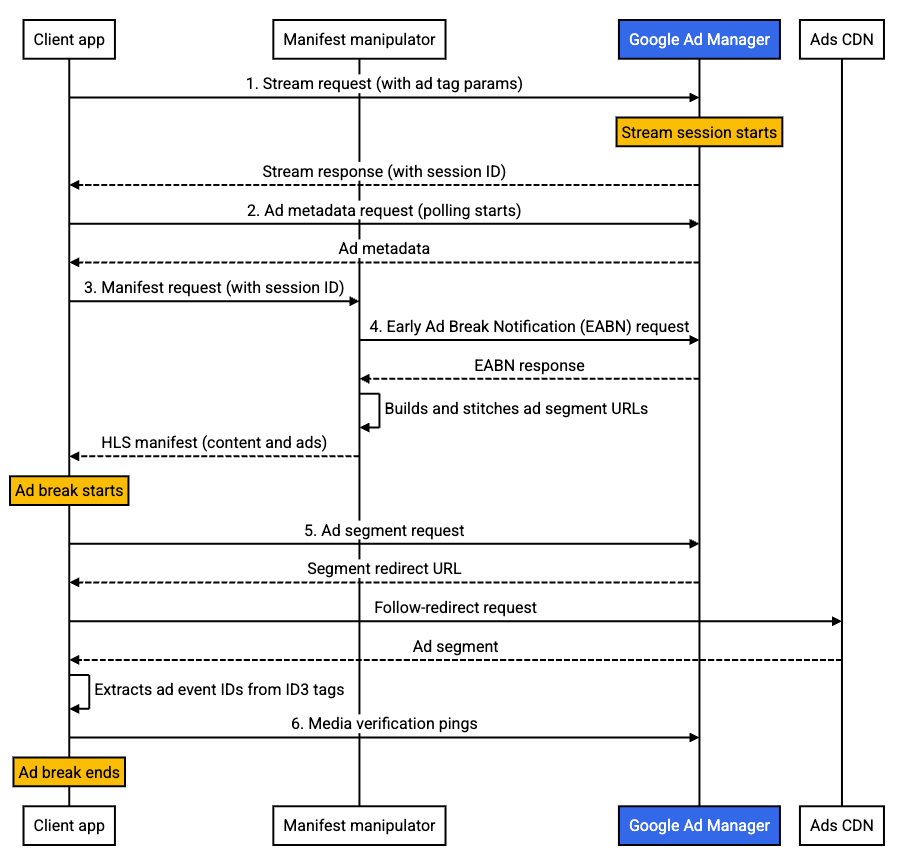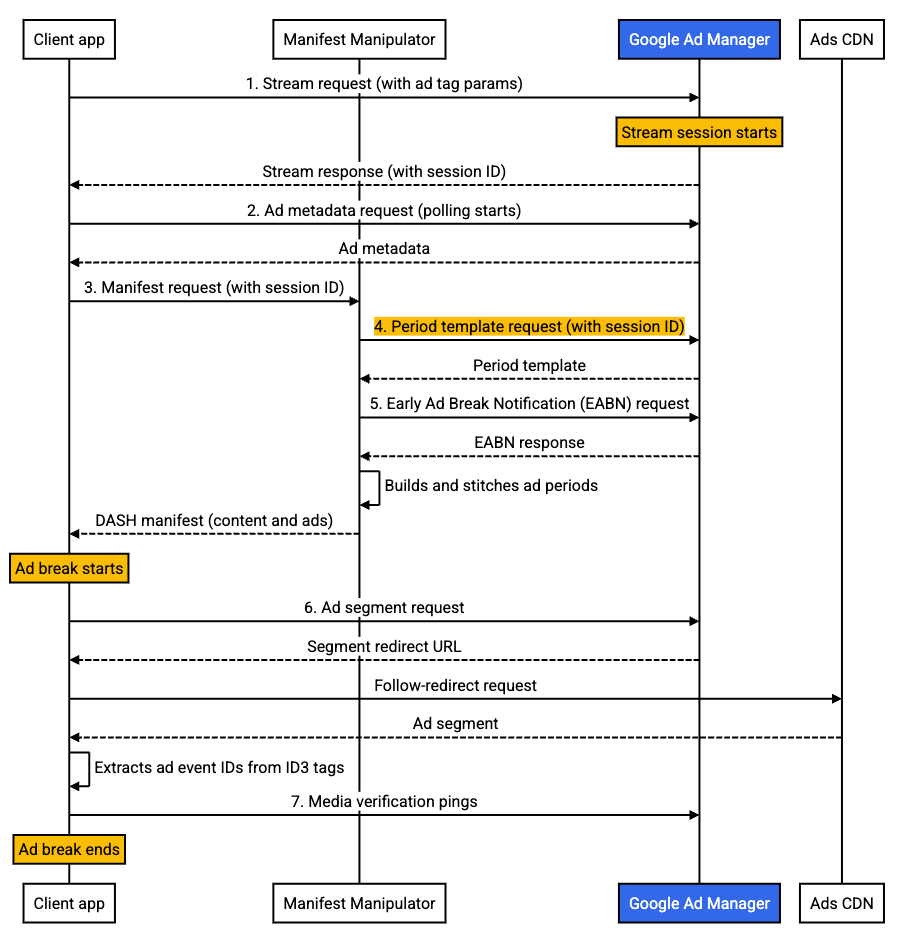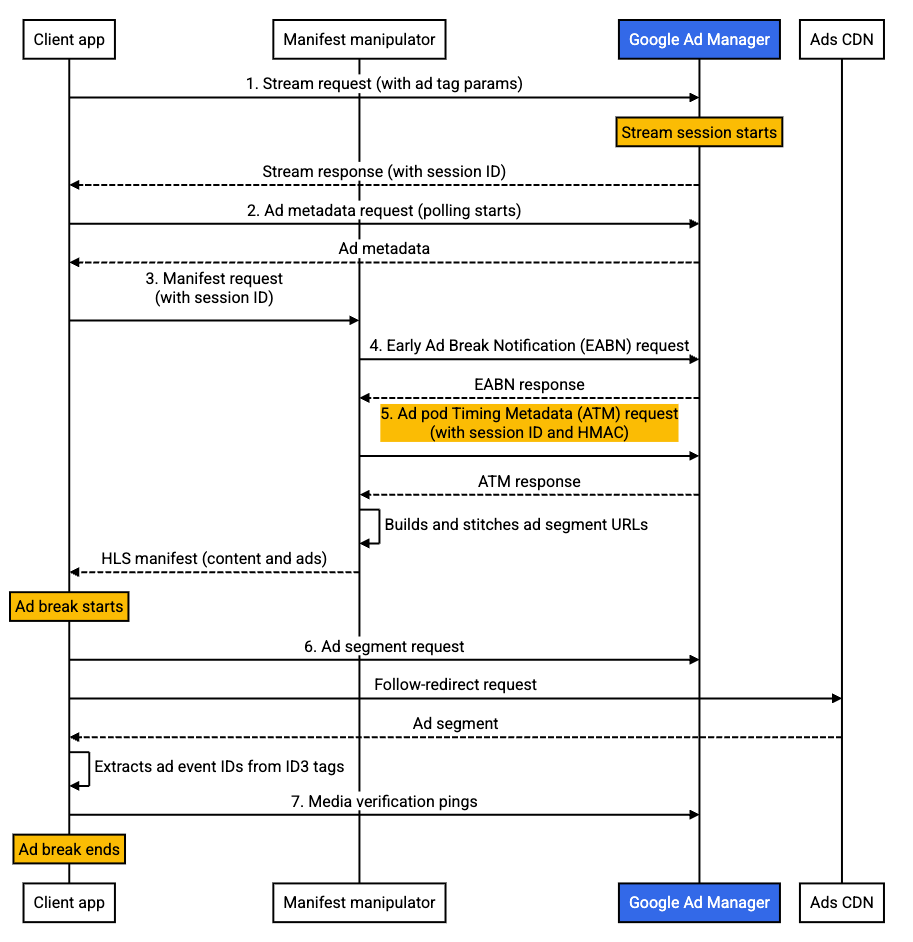如需使用 HLS 或 DASH 直播实现服务器端广告插播 (SSAI),请使用 Pod Serving API 请求自适应码率广告 Pod。如需了解支持的分辨率和比特率,请参阅视频和音频格式及转码。
本页介绍了如何将广告连播投放 API 用于直播。
前提条件
在继续之前,您必须具备以下条件:
配置直播活动,并将其动态广告插播 (DAI) 类型设置为 Pod Serving 重定向。选择以下任一选项:
- 设置 DAI 直播。
- 选择一个 SOAP API 客户端库,然后使用
LiveStreamEvent对象和设置为POD_SERVING_REDIRECT枚举的dynamicAdInsertionType类型调用LiveStreamEventService.createLiveStreamEvents方法。如需查看所有客户端库,请参阅客户端库和示例代码。
在网络浏览器、移动设备或电视中运行的客户端应用,用于加载视频流和处理事件,例如播放、暂停、点击或点按。
用于处理来自客户端应用的流请求的清单操纵器。 重要提示:对于清单服务,我们建议采用高级投放流程。
已启用 Pod Serving DAI 的 Google Ad Manager 账号。
基本投放流程
如需传送直播,请选择一种直播协议,然后执行以下操作:
HLS
如需注册会话,请从视频播放器向 Google Ad Manager 发出视频流请求。
开始轮询广告元数据,以获取即将发生的广告事件。
从清单操纵器请求直播清单。
可选:向 Google Ad Manager 发送广告插播时间点提前通知。 重要提示:我们建议您执行此步骤,以提高填充率。
当清单操纵器检测到广告插播标记时,构建广告片段网址并将其拼接到清单中。
- 在广告插播期间,客户端视频播放器会请求广告片段,并按照片段重定向网址下载广告片段文件。
从 ID3 标记中提取广告事件 ID,以查找媒体验证 ping 并将其发送给 Google。

DASH
按照 HLS 标签页中的所有步骤操作。
请求一次 DASH 时段模板并缓存该模板。此方法会构建会话中所有广告插播时间段的周期。

高级投放流程
如需投放直播,请选择直播协议:
HLS
如需注册会话,请从客户端视频播放器向 Google Ad Manager 发出视频流请求。
开始轮询广告元数据,以获取即将发生的广告事件。
从清单操纵器请求直播清单。
可选:向 Google Ad Manager 发送广告插播时间点提前通知,以提高填充率。
向 Google Ad Manager 发出广告插播时间元数据 (ATM) 请求。
检索精确的广告插播时间和插播广告时间,以构建广告片段网址。
将广告片段网址缝合到清单中。
当清单操纵器检测到广告插播标记时,构建广告片段网址并将这些网址拼接到清单中。
- 在广告插播期间,客户端视频播放器会请求广告片段,并按照片段重定向网址下载广告片段文件。
从 ID3 标记中提取广告事件 ID,以查找媒体验证 ping 并将其发送给 Google。

DASH
按照 HLS 标签页中的所有步骤操作。
使用广告插播时间元数据 (ATM) 响应来构建 DASH 时段,其中包含其他必需字段。

分步说明
如需详细了解 API 端点、示例请求和响应数据,请参阅直播的客户端视频播放器应用和直播的清单操纵器。

